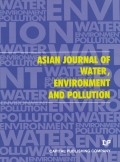Authors: P., Rekha | Raj, D.S. Suman | Aparna, C. | Bindu, V. Hima | Anjaneyulu, Y.
Article Type:
Research Article
Abstract:
Land contamination is one of the prominent and widely addressed problems and is gaining importance in many developed and developing countries. It is now widely accepted that contaminated land is a potential threat to human health and over recent years has led to international efforts to remediate many of these sites, either as a response to the risk of adverse health or essential effects caused by contamination or to enable the site to be redeveloped for
…use. Traditional methods simply move the contaminant or may create significant risk in handling the hazardous materials involving cost intensive and potential liabilities. Physical and chemical methods can be effective but are technically complex and lack public acceptance. Bioremediation is an option that offers the possibility to destroy or render harmless various contaminants using natural biological activities. It uses relatively cost-effective low technology techniques, which have high public acceptance and can be carried out on-site. In the present study, composting is demonstrated as a full-fledged bioremediation methodology for the stabilization of contaminated lake sediments. Lab scale studies were carried out to examine the various bioprocesses occurring in composting using simulated soils and optimized conditions are established for bioremediation of lake sediments contaminated with organics and heavy metals. In order to enhance microbial activity in composting, neutralization of the contaminated lake sediments was carried out by adding commercially available lime and then, organic and inorganic fertilizers like cowdung, poultry manure, urea, and superphosphate as initial microbial seeding amendments, bulking agents like sawdust and nutrients are provided and the impact of their variation was also studied. Continuous monitoring of process control parameters like pH, moisture content, electrical conductivity, total volatile solids and various forms of nitrogen etc. were carried out. The stability of the compost was evaluated by assessing maturity indices like C/N, C_w (water soluble carbon), CN_w (C_w /N_w ), nitrification index (NH_4 /NO_3^- ), cation exchange capacity (CEC), germination index, humification index, humification ratio, compost mineralization index (ash content/oxidizable carbon), sorption capacity index (CEC/oxidizable carbon). Enzyme activities of agricultural interest like urease, phosphatase, β-glucosidase, dehydrogenase and BAA-hydrolyzing protease, which are involved in the nitrogen, phosphorus and carbon cycles, were also assessed. Total content of macro and micronutrients in the final compost was also determined to assess the fertilizer value.
Show more
Citation: Asian Journal of Water, Environment and Pollution,
vol. 3, no. 1, pp. 57-68, 2006
Price: EUR 27.50





